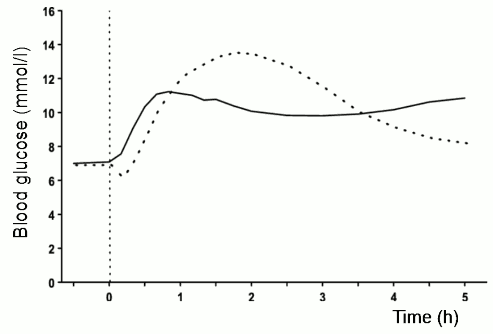Insulin aspart
Chemical formula: C₂₅₆H₃₈₇N₆₅O₇₉S₆ Molecular mass: 5,832 g/mol
Pharmacodynamic properties
The blood glucose lowering effect of insulin aspart is due to the facilitated uptake of glucose following binding of insulin to receptors on muscle and fat cells and to the simultaneous inhibition of glucose output from the liver.
Insulin aspart produces a more rapid onset of action compared to soluble human insulin, together with a lower glucose concentration, as assessed within the first four hours after a meal. Insulin aspart has a shorter duration of action compared to soluble human insulin after subcutaneous injection.
Fig. I. Blood glucose concentrations following a single pre-meal dose of insulin aspart injected immediately before a meal (solid curve) or soluble human insulin administered 30 minutes before a meal (hatched curve) in patients with type 1 diabetes mellitus:
When insulin aspart is injected subcutaneously, the onset of action will occur within 10 to 20 minutes of injection. The maximum effect is exerted between 1 and 3 hours after injection. The duration of action is 3 to 5 hours.
Pharmacokinetic properties
Absorption, distribution and elimination
Substitution of amino acid proline with aspartic acid at position B28 reduces the tendency to form hexamers as observed with soluble human insulin. Insulin aspart is therefore more rapidly absorbed from the subcutaneous layer compared to soluble human insulin.
The time to maximum concentration is, on average, half of that for soluble human insulin. A mean maximum plasma concentration of 492±256 pmol/l was reached 40 (interquartile range: 30-40) minutes after a subcutaneous dose of 0.15 unit/kg bodyweight in type 1 diabetic patients. The insulin concentrations returned to baseline about 4 to 6 hours after dose. The absorption rate was somewhat slower in type 2 diabetic patients, resulting in a lower Cmax (352±240 pmol/l) and later tmax (60 (interquartile range: 50-90) minutes). The intra-individual variability in time to maximum concentration is significantly less for insulin aspart than for soluble human insulin, whereas the intra-individual variability in Cmax for insulin aspart is larger.
Special populations
Elderly (≥65 years old)
The relative differences in pharmacokinetic properties between insulin aspart and soluble human insulin in elderly patients (65-83 years, mean age 70 years) with type 2 diabetes were similar to those observed in healthy subjects and in younger patients with diabetes. A decreased absorption rate was observed in elderly patients, resulting in a later tmax (82 (interquartile range: 60-120) minutes), whereas Cmax was similar to that observed in younger patients with type 2 diabetes and slightly lower than in patients with type 1 diabetes.
Hepatic impairment
A single dose pharmacokinetic study of insulin aspart was performed in 24 subjects with hepatic function ranging from normal to severely impaired. In patients with hepatic impairment, absorption rate was decreased and more variable, resulting in delayed tmax from about 50 min in subjects with normal hepatic function to about 85 min in patients with moderate and severe hepatic impairment. AUC, Cmax and CL/F were similar in patients with reduced hepatic function compared with subjects with normal hepatic function.
Renal impairment
A single dose pharmacokinetic study of insulin aspart in 18 subjects with renal function ranging from normal to severely impaired was performed. No apparent effect of creatinine clearance values on AUC, Cmax, CL/F and tmax of insulin aspart was found. Data were limited in patients with moderate and severe renal impairment. Patients with renal failure necessitating dialysis treatment were not investigated.
Paediatric population
The pharmacokinetic and pharmacodynamic properties of insulin aspart were investigated in children (6-12 years) and adolescents (13-17 years) with type 1 diabetes. Insulin aspart was rapidly absorbed in both age groups, with similar tmax as in adults. However, Cmax differed between the age groups, stressing the importance of the individual titration of insulin aspart.
Preclinical safety data
Non-clinical data reveal no special hazard for humans based on conventional studies of safety pharmacology, repeated dose toxicity, genotoxicity and toxicity to reproduction and development.
In in vitro tests, including binding to insulin and IGF-1 receptor sites and effects on cell growth, insulin aspart behaved in a manner that closely resembled human insulin. Studies also demonstrate that the dissociation of binding to the insulin receptor of insulin aspart is equivalent to human insulin.
Related medicines
© All content on this website, including data entry, data processing, decision support tools, "RxReasoner" logo and graphics, is the intellectual property of RxReasoner and is protected by copyright laws. Unauthorized reproduction or distribution of any part of this content without explicit written permission from RxReasoner is strictly prohibited. Any third-party content used on this site is acknowledged and utilized under fair use principles.
